-
Car Reviews
- All reviews
- Midsize SUVs
- Small cars
- Utes
- Small SUVs
- Large SUVs
- Large cars
- Sports SUVs
- Sports cars
- Vans
Latest reviews
- Car News
-
Car Comparisons
Latest comparisons
- Chasing Deals
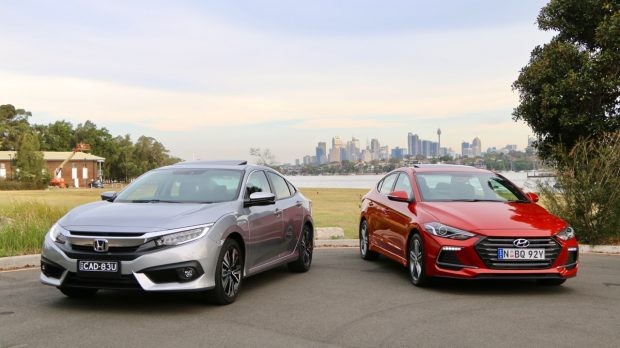
For years, the best small cars – like the Volkswagen Golf and the Ford Focus – have exclusively used turbo engines. With generous torque and superior refinement, Euro turbos are more appealing to drive than most of their Asian counterparts, most of which soldier on with non-turbo four-cylinder engines. Reliable – sure. Interesting? Not really. So what happens when two of the top small cars out of Asia in the last year adopt the Euro turbo formula? Honda and Hyundai are finding out. The Hyundai Elantra SR Turbo has gained the 1.6-litre turbo from the Veloster, while the Honda Civic 1.5T uses a new boosted VTEC engine. Both cars aim to inject more driving flair into two otherwise very respectable packages.
So Civic and Elantra have common purposes – be more fun, and be more refined. But that’s largely where the similarities end. These might both be four-cylinder turbo sedans, but these are different beasts. For starters, Honda and Hyundai have positioned their turbos in pretty different ways.
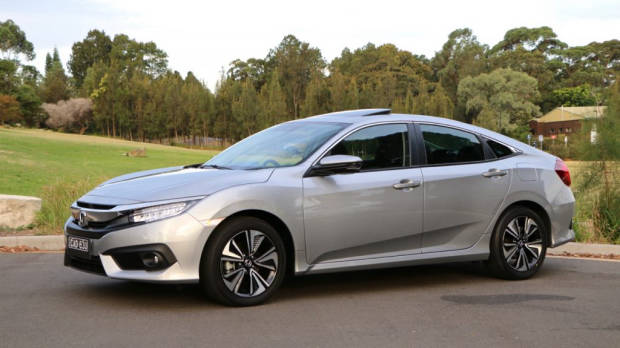
For the Civic – which debuted in 2016 – the 127kW turbo is the workhorse engine of the range. It powers three out of the five variants, starting at $27,790 – only the base VTi and second-tier VTi-S keep Honda’s old non-turbo 1.8-litre. There’s no manual on offer – the Civic pairs the turbo exclusively to a CVT automatic.
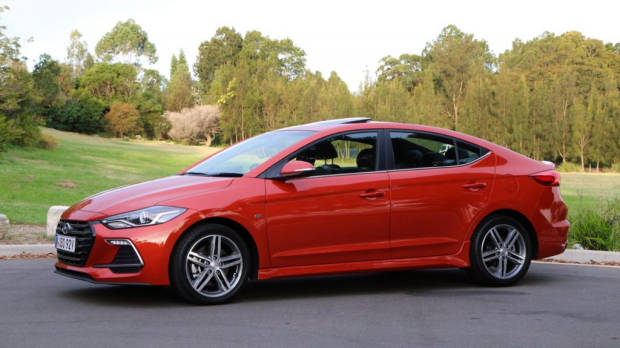
At Hyundai, the Elantra’s potent 150kW turbo is the premium engine. It’s exclusive to the range-topping SR Turbo. It costs $28,990 for the manual or $31,290 for a double-clutch automatic – affordable, though not as accessible as a boosted Civic. However, the Elantra SR Turbo competes squarely with the sporty-looking Civic RS ($31,790). An RS wasn’t available for this comparison, so we drove the flagship Civic VTi-LX turbo ($33,590).
On paper, these cars use a similar formula – they’re front-driver sedans with four-pot turbos that weigh about 1300kg. However, they have totally different driving characters, and both cars will appeal to different drivers in different ways.
Fundamentally, the Honda Civic turbo is a cruiser. The 1.5-litre engine is quite strong – with 127kW of power and 220Nm of torque, it’s competitve with the 110kW and 250Nm of a loaded Volkswagen Golf Highline. However, the sedate tuning of the new Honda engine mean that the Civic is at its best when driven smoothly.
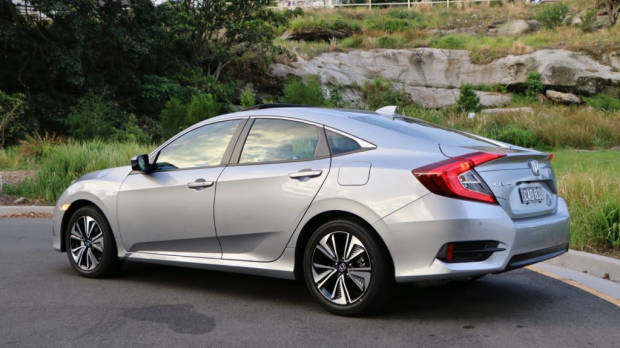
The big reason for the conservative style of the Honda’s power delivery is the CVT automatic gearbox. With the exception of cars like the Subaru WRX, CVT autos rarely perform well under a hard driving style. Instead of changing gears – which makes a pleasant sound in most cars – CVTs hold revs at a steady rate, which translates as a droning noise. So, punching the 127kW Civic turbo means quick progress, but noisy progress.
Drive the Civic with a gentle right foot and you won’t notice the transmission’s deficiencies – driven smoothly, the Civic feels refined and nimble. That’s aided by quick, darty steering, balanced handling, and a chassis that is feels incredibly solid and richly engineered, with real hints of Golf coming through in the way the Civic rides and handles imperfect roads.
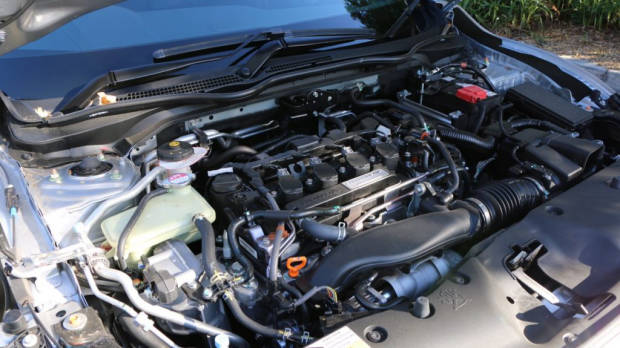
On the other hand, the Elantra SR Turbo does a remarkable imitation of a sports sedan. Unlike the Civic, the Hyundai’s turbo isn’t here for the sake of economy – the Elantra’s 1.6-litre is a performance-oriented engine. The generous dollop of power – 150kW – and decent 265Nm of torque indicate that there might be some fun to be had here – and there is.
The Hyundai’s engine is very strong throughout the rev range but especially in the hearty mid-range where the torque really makes its presence known. There is a little rasp to the exhaust, too. Plus, a mostly excellent pairing with the seven-speed double clutch automatic guarantees that the Hyundai is the more pleasurable turbo to drive in this twosome.
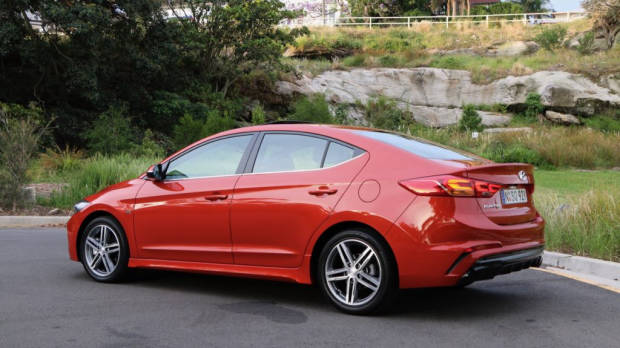
Like with Volkswagen’s DSG double-clutch transmissions, the Hyundai can feel slightly laggy in lower-speed shifts like first to second gear – but on the whole, the DCT is a well-tuned and snappy transmission. Plus, the optional availability of a considerably cheaper six-speed manual is something that we like.
While the Hyundai’s engine and transmission are more convincing than the Honda’s setup, it’s in the ride and handling departments where the Civic has the Elantra beat.
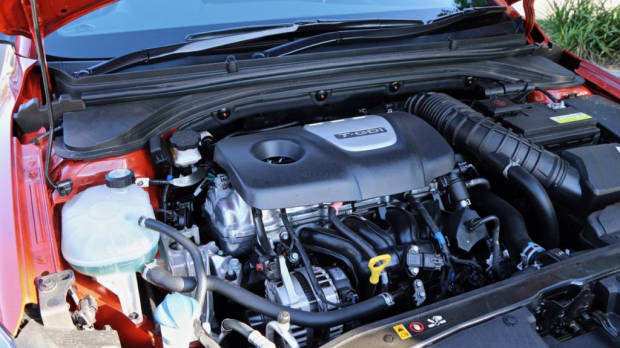
That’s something of a surprise, because in standard form the Elantra is one of the best-riding small cars around – however, the SR’s unique suspension tune reintroduces a hard edge to bumps. Plus, while the Hyundai’s steering is good, it isn’t quite a match for the Civic’s classic Honda-feel steering, which is quicker and more natural – an ideal partner if you mostly drive in the city.
Though the Elantra and Civic are routinely referred to as ‘small’ cars, they’ve grown significantly over the years. Realistically, they’re both medium-sized – but especially the Civic, which at 4.64 metres, is actually longer than a BMW 3 Series, and measures in at seven centimetres longer than the Elantra.
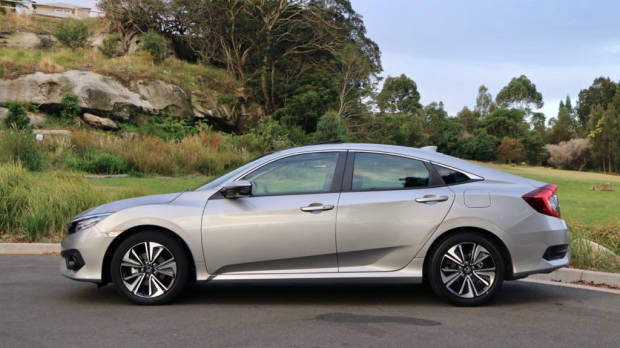
The Honda’s length means the Civic feels generously-sized inside. There is plenty of room in the cabin – particularly in the cavernous back seat that feels more Commodore than Golf. For passengers travelling in the back of the Civic, there is huge legroom and decent headroom, despite the Honda’s coupé-like roofline.
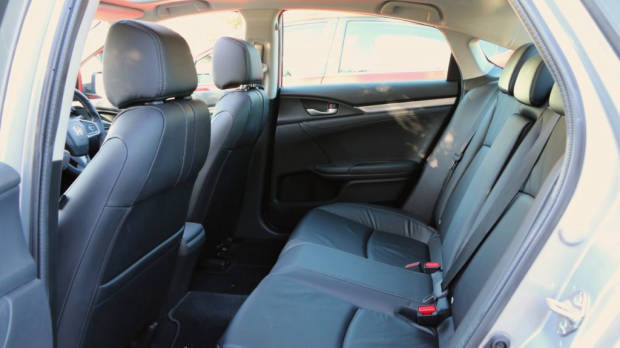
Plus, the 519 litre boot is the biggest in this class – because the Civic is so long.
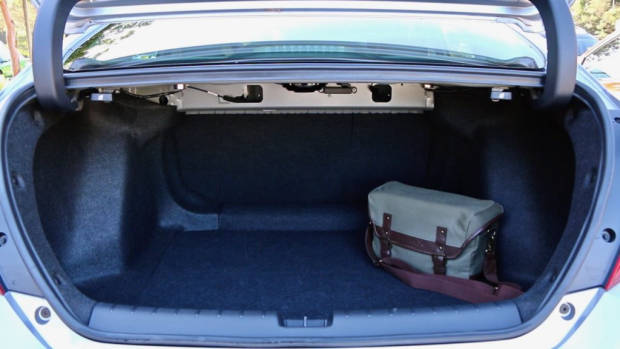
The length does mean that the Civic feels big when parking – something to keep in mind if you’re upgrading from an older, more compact generation of this ‘small’ Honda.
There is plenty for those travelling up front in the Honda to like, though – and that starts with the sporty driving position. The Civic must have the lowest-slung driver’s seat in this class – the seat can be adjusted into a genuinely low and very sporty position providing a great view out and a real sense of connection to the car. We like that.
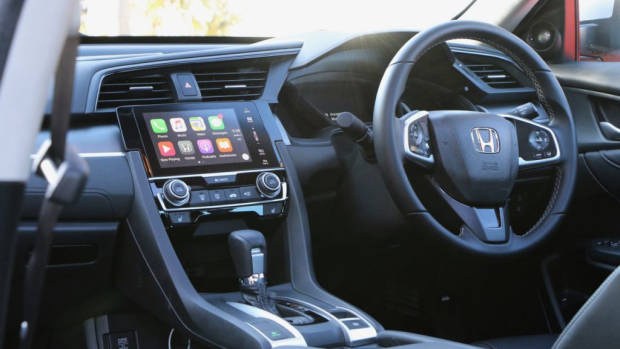
The Civic’s front seats are also relatively comfortable, though they are shaped quite uniquely – some of our drivers found them comfortable, and others didn’t. The leather is soft and feels more premium, though, and the seats are also heated.
Plus, the Civic’s interior is well-designed, with all the controls within reach. The climate controls are old school and simple to learn. The glossy touchscreen sits close to the driver, and, if you’re running Apple CarPlay or Android Auto, it’s easy to use. The standard Honda software isn’t the best out there, though. Only the top-spec Civic VTi-LX comes with built-in navigation – otherwise, you’re forced to mirror your smartphone to project navigation.
Honda have gotten rid of a volume knob, and the volume is instead adjusted through a slightly cumbersome touch slider. The stereo does produce crisp sound, however.
We thought the more conventionally-sized Elantra was a very well-packaged small sedan when we drove the non-turbo model earlier in 2016 – and that remains the case in the SR Turbo. The tighter dimensions mean that the Hyundai will squeeze into tighter parking spots, too.
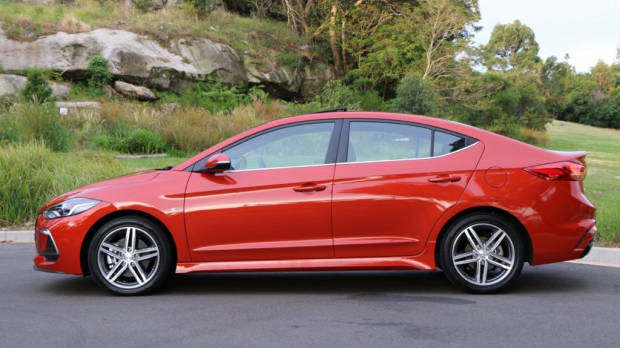
You do notice that the Elantra is shorter when you’re sitting in the back, though the legroom is still generous enough for a six-footer. The taller roofline also means that there is a touch more headroom back there in the Hyundai.
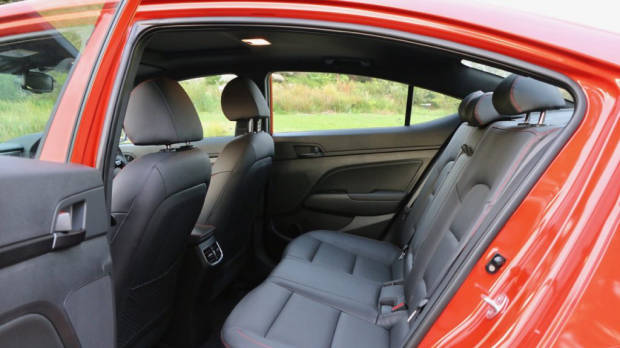
Plus, the 458 litre boot isn’t too shabby, with a nice, wide opening.
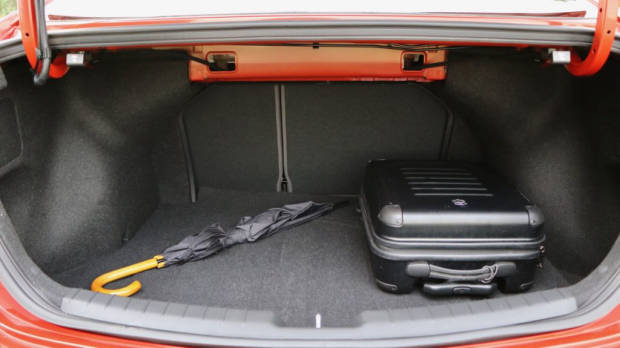
The best description for the Elantra’s cabin would be smart and handsome, rather than exciting. Like in all Hyundais, the controls are all dead easy to understand and the dash itself looks like it’s from a more expensive class of car. However, the touchscreen is grainier than the Hondas, and it’s also more of a stretch for the driver to touch. Luckily, many key controls are duplicated on the steering wheel. The stereo could use a bit more punch, but the faux carbon fibre trim looks cool here.
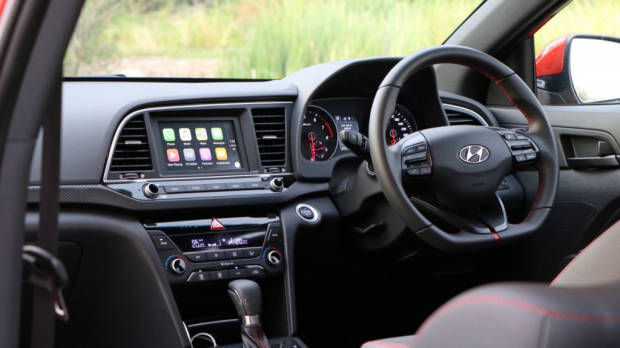
Keep in mind that the Elantra isn’t available with navigation as standard – you have to plug in your iPhone or Android smartphone to use mirroring. That’s not necessarily a bad thing – generally smartphone nav is superior – but you do need to keep sufficient data on your phone to use this.
That sporty wheel is one of the best parts of the Elantra’s cabin – it’s small, flat-bottomed and features red stitching and perforation to really send the message that the Elantra wants to be driven. The wheel is paired to new instrumentation that mimics a Mercedes-AMG – the dials look very cool.
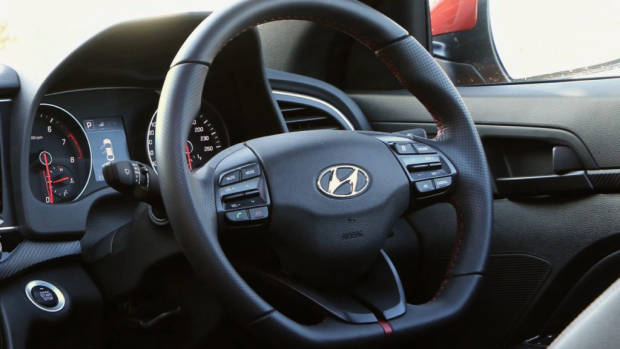
While the Elantra’s heated leather seats aren’t quite as soft to the touch as the Civic’s, they’re more supportive for more drivers. We wish they could be adjusted lower, but the side and back bolstering is more generous than the Honda, and the Elantra was the more comfortable car for both errands and cruising.
There are four main running costs to any vehicle – maintenance, fuel, insurance and depreciation.
For the purposes of this section, we’ll be comparing the single-model Elantra SR Turbo auto ($31,290) to its most direct competitor, the Honda Civic RS ($31,790).
Servicing and scheduled maintenance
Both the Hyundai Elantra SR Turbo and Honda Civic RS are covered by capped price servicing programmes. For the Hyundai, it’s a lifetime programme of capped services. Honda offers five years or 100,000km of capped services through its Tailored Servicing system.
Both of these cars have a frustrating service interval of the first of 12 months or every 10,000 kilometres. Given the average Australian driver does 14,000 kilometres annually, that effectively means servicing every nine months.
Over three years of ownership, the Civic costs $1,124, while the Elantra is slightly cheaper to service at $1,076 for three years.
Fuel – filling up with petrol
The Hyundai is thirstier than the Honda – the claimed combined economy of the Elantra turbo is 7.2L/100km, versus 6L/100km for the Civic turbo. Both cars came relatively close to their claim on test.
At current petrol prices, over three years the Hyundai would use $3,943 in petrol compared to $3,286 for the Honda.
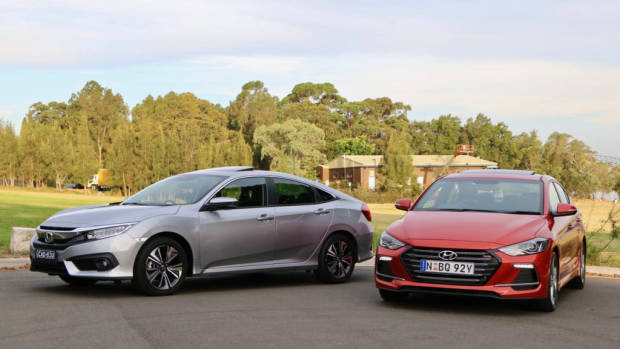
Insurance
We sought insurance quotes from mainstream insurers based on a 30 year old living in Chatswood, NSW, with a good driving history.
On average the Civic costs $1,040 to insure – or $3,120 over three years. The Elantra quotes were $912 on average, or $2,736 over three years.
Depreciation – losses when you sell the car
Based on three years of ownership at 14,000km per year – the average – Glass’ Guide indicates that the Hyundai will keep a slightly disappointing 53.7% of its value, and fetch about $16,800 – meaning depreciation of $14,490 over three years.
The Honda depreciates at a much slower rate, retaining about 62% of its value and would fetch about $19,700 if sold in three years’ time – depreciation of $12,090.
The Civic costs less to run
Though the Honda Civic RS costs $500 more to buy new than the Hyundai Elantra SR Turbo, it more than recoups that when you consider the costs of running the cars and selling them after three years of ownership.
If you bought the Honda Civic now and sold it in three years, it would have cost you about $19,620, including depreciation. Compare that to the Elantra SR Turbo, which if sold in three years, would have cost you about $22,246 – $2,626 more than the Civic. So, if this is a value based purchase, the Honda is the less expensive option.
If you’re looking for a practical but punchy sedan for just over $30,000, the Hyundai Elantra SR Turbo and Honda Civic RS – or any Civic turbo model – are two of the best options out there.
The new Honda Civic is a terrific cruiser, with soft leather seats, a great driving position, a torquey turbo that glides around with ease and really fun handling that reminds us of old-school Hondas.
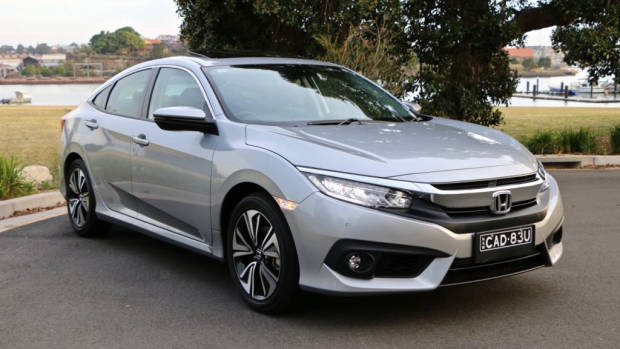
If you’re after a refined and comfortable car that you’ll mainly drive smoothly and gently, the Civic is the pick here.
However, if you want a some driving fun from your small sedan, it has to be the Hyundai with its peppy, zesty 1.6-litre turbo. From the moment you slide behind the new red-stitched steering wheel and hear the revised exhaust, you know the Hyundai wants to be driven.
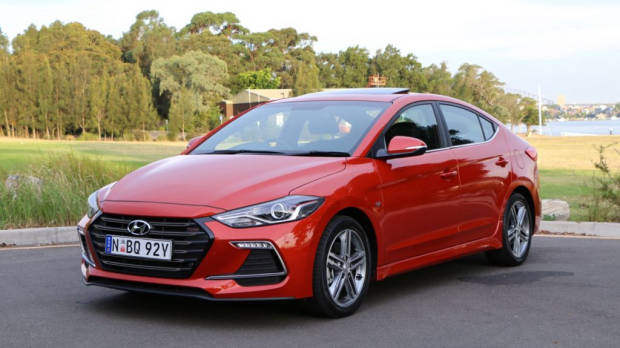
The double-clutch automatic and turbo make a great combination – the Elantra is swift and satisfying to drive, with sporty dynamics and good looks. Niggles like slightly higher fuel consumption and a touchscreen that is a bit far from the driver are easily overlooked.
That’s why our overall recommendation goes to the 2017 Hyundai Elantra SR Turbo – but both of these cars deserve your close consideration if you are in the market.
Latest comparisons
About Chasing cars
Chasing Cars reviews are 100% independent.
Because we are powered by Budget Direct Insurance, we don’t receive advertising or sales revenue from car manufacturers.
We’re truly independent – giving you Australia’s best car reviews.